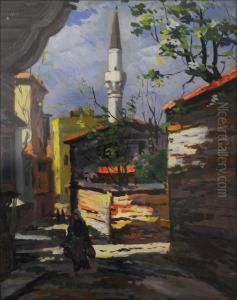Albin Muller Paintings
Albin Müller, also known as Albinmüller or Albin Mueller, was a German architect, designer, and representative of the Jugendstil movement, which is the German version of Art Nouveau. Born on June 18, 1871, in Darmstadt, Germany, Müller was part of a generation of artists and architects who aimed to create a new style that would reflect the modern era, breaking away from historical imitations and embracing organic, flowing designs.
Müller initially trained as a woodcarver and studied at the Academy of Fine Arts in Munich, where he was influenced by the teachings of Jugendstil proponents. His career spanned various fields, including architecture, furniture design, and decorative arts. He was particularly known for his holistic approach to design, where he sought to integrate the various elements of a building or interior into a unified artistic concept.
One of Müller's significant contributions was his involvement with the Darmstadt Artists' Colony, a community founded by Grand Duke Ernst Ludwig of Hesse in 1899 to bring together leading artists and architects of the time. As part of this collective, Müller designed several buildings and interiors, combining functional aspects with aesthetic considerations. His work at the colony, including his own residence known as the 'Haus Glückert', showcased his commitment to creating a total work of art, encompassing everything from the structure to the furnishings and decorative elements.
During the early 20th century, Müller's style evolved to include elements of the emerging Art Deco movement, which began to favor geometric forms and stylization over the fluid lines of Art Nouveau. Despite this shift, his dedication to craftsmanship and the integration of art into daily life remained constant.
Albin Müller's influence extended beyond his own practice as he also taught at various institutions, including the Kunstgewerbeschule (School of Arts and Crafts) in Magdeburg, where he served as director from 1919 until his retirement in 1933. Müller's work during this period included the design of the city's war memorial, showcasing his ability to adapt his artistic vision to a variety of mediums and scales.
Müller's legacy is seen not only in his own creations but also in his impact on the development of modern design principles. His approach to holistic design and the fusion of functionality with aesthetics can be traced in the philosophies of the Bauhaus and other modernist movements. Albin Müller passed away on October 2, 1941, in Darmstadt, leaving behind a body of work that continues to be studied and admired for its contribution to the evolution of design.
